Updates: Chinese Composition & Jay
Date: Sep 13, 2015
Learning how to speak and write in Chinese is a long term process.
You will see the result slowly after many days. You cannot expect to see good result in a few weeks.
But slowly, the more you practice, the more you get familiarise and the more you learn how to write in this beautiful language.
Here is some more tips on how I train my son on how to improve his Chinese Composition.
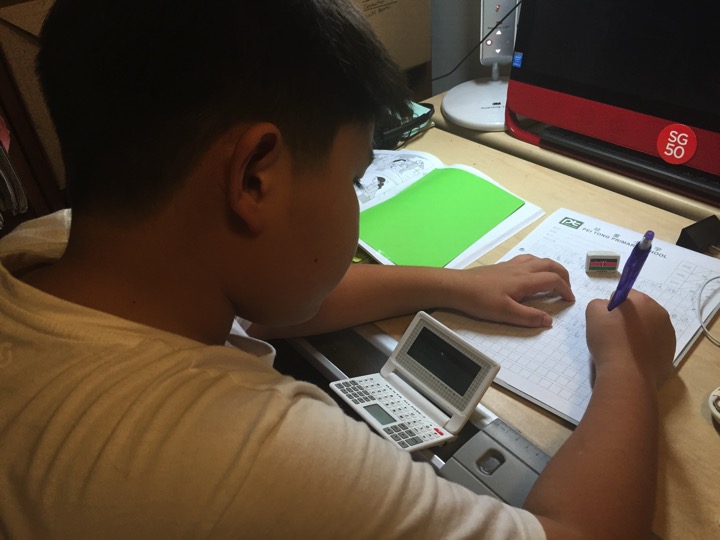
1. You have to buy some material to practice. One of the book I found it very useful is this book I got from Popular Bookstore. It is by Victoria Publications Pte Ltd. It has 72 Chinese Essay / Chinese Composition models. With Han Yu Pin Yin too. Of course, their model answer is very chim, deep. But it is always good for Jay to look at the model answer.

Here are the titles of the 72 Chinese Essays.

Jay told me that he saw some of them in school. Those photos are quite standard. But of course the answers are from the Publishers.

I think it is a very good idea from time to time, we pick out one topic and brainstorm together to write the Chinese Composition. The P3 kids only need to write at least 80 words.
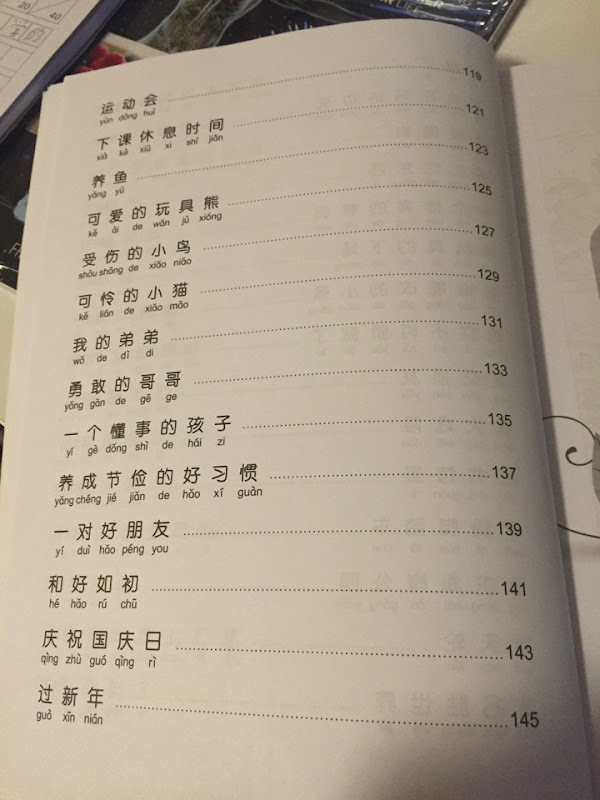
2. In my earlier posting (you may search the blog site with “Miniliew Chinese”, you see that I uses a IOS app called Dragon Dictation. This is a software app you use to dictate what you say into a writing. Means, you speak to the iPhone App, and Dragon Dictation will automatically write down for you of what you speak. This App is useful, when you want to quickly note down what you say without a pen and pencil.
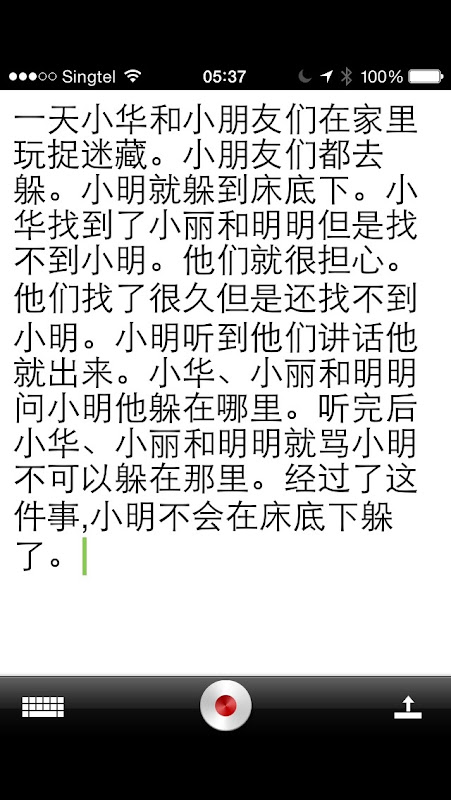
3. I did the Chinese Composition together with Jay whenever we drove in the car to his enrichment class, i.e. Robotics, CMA, Golf or Badminton. It is good as during the car journey, which is usually about 10min to 20min drive, you want the kid to use his brain to brainstorm in his mind. Ask him to look at the pictures, tell him to describe what he sees.
The key objective is to discuss about it, and be able to describe what you see. Describing what you see and write it down is probably the hardest part. Our kids nowadays are slowly skewed towards English speaking mode whenever possible. So, you have to correct his Chinese speaker all the time, when he did a “direct translation” from English. The order of sentences are very important. By doing this sort of exercise, you can make sure that he slowly learn how to speak Chinese in the correct order, correct way. And as he speak correctly, he can learn how to write it down correctly too.
Today, it is the first time, we did not use Dragon Dictation. As we are entering a higher stage. :)
Me and Jay is discussing about these 4 pictures in the car while on our home from Robotics class.
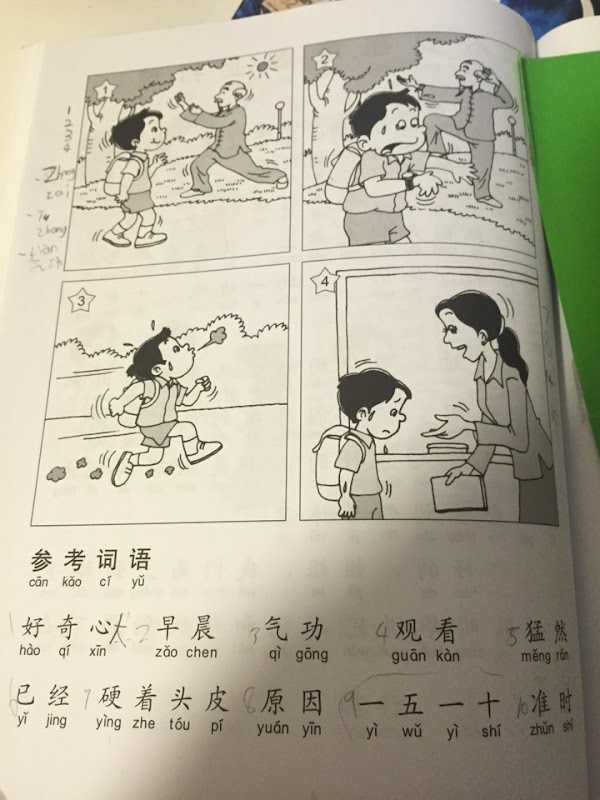
4. First you must teach the kids how to count. For example, there are 19 squares in each row. So, that means, as long as you have written and “fill up” at least 5 rows, you are OK. In P3, you are required to write at least 80 characters word counts.
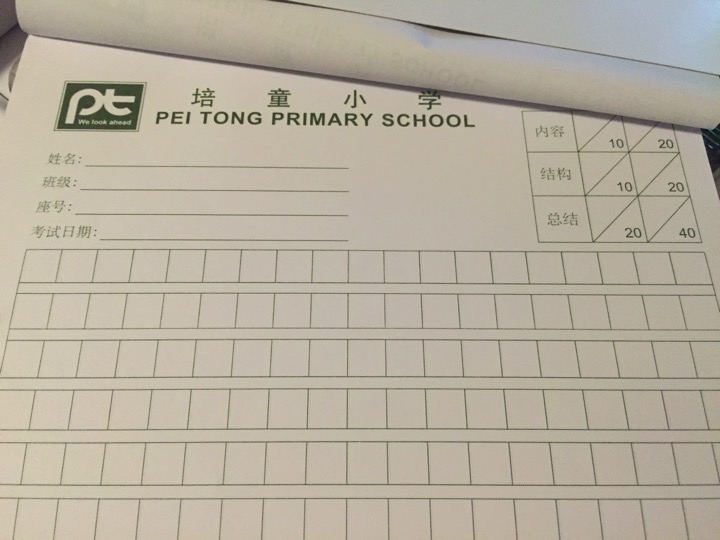
5. I asked Jay to “label” all the helping words. The key is you do not need to use up all the helping words. But it generally gives you clues on what story is the pictures is about.

6. Then, I asked him to try to “fit” those labeled words into which pictures. The boy is curious, so 好奇心 definitely goes into picture no. 1. It is a lovely morning, 早晨 goes to picture no. 1. The old man is practising his Qi Gong (气功), so it goes into no. 1. And so on.
Also, if you thought of any other words, and if you DO NOT KNOW how to write it in Chinese, but you do know how to SAY IT. Then write down the Han Yu Pin Yin beside it. It is the fastest way to note down what you try to say. For example, he knows how to speak out 练习气功, but he does not know how to write the Lian (练) word. So, I would encourage him to write it down in Han Yu Pin Yin first.
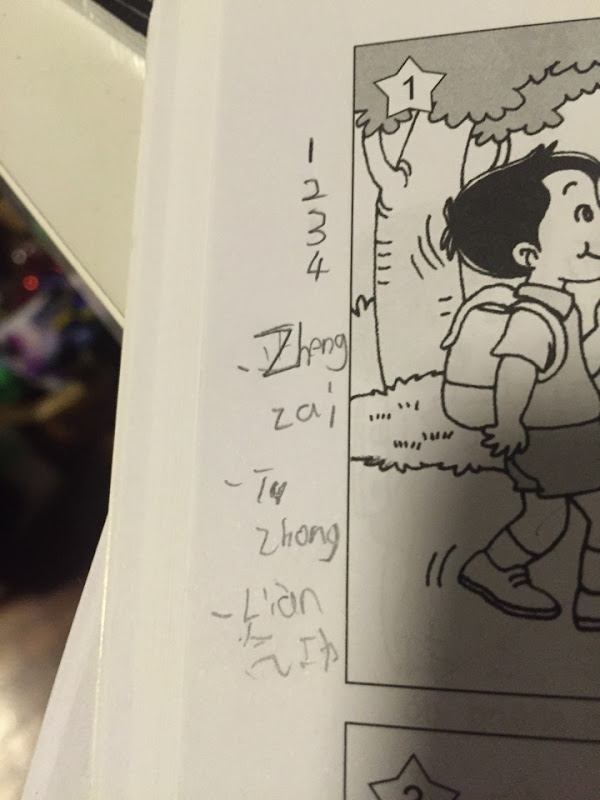
And he decided that 7-10 will place in the last picture.

And if you decided that you don’t want to use any of the helping words, simply cross them out. I teach Jay that if he put down the label number beside the picture, it is easier.

7. In the Chinese composition class, students are allowed to use the e-dictionary.

The teacher in school should have already taught them how to use it. And you got to make sure your kids know how to use it. So, remember, Jay wrote down the Han Yu Pin Yin, “正在“ (Zheng4 Zai4), ”途中“ (Tu2 Zhong1), ”练” (Lian4). When he write the Chinese Composition on the paper, he will make use of the e-Dictionary to find the correct words.

8. After spending 10-20 min in the car going thru describing and telling story. He is now ready to put it in writings. So, when we arrive home, I tell him, you have 20-30 minutes to write at least 80 words. So, he started to get to work.
Notice that this time, I never use the Dragon dictation for this exercise as I want to see what is the result of what we have done for the past few weeks (only manage to do it in weekend).
Not too bad. Not too bad at all.
So, from here, he understood clearly how much is 80 words. So, during the brain storming sessions, we talk about almost every thing. And whatever we spoke, may be can reach 200-300 words. But when he write, I asked him to look at the picture again, and use your finger to do a quick count on what you want to say. And if you think it is too short, you add in more descriptions. If you think it is too long, try to cut down things that is repeated. Things that is not so important, etc.
At the moment, Jay’s Chinese tutor also let him read P5 passage. According to the Chinese tutor, he says actually P4, P5 text book is the same. Chinese is about learning the characters. The more you learn the Chinese characters the more power you are. As I spoke about it before, the way how the Chinese Tutor teach Jay is he recorded down his reading of text book on iPhone and ask Jay to read ONLY ONCE per day. His theory is, if the student is able to read it out loud a text book passage, he should know and understand every words he read. And you cannot force him to read two times a day as it might loose the child interest in Chinese. You read it ONCE, is not too much. And of course, I bought 2 extra text book for him so that one is used to write down the meaning of NEW WORDS. And the other one, I have to blanco erase out all the Han Yu Pin Yin. That means, when Jay read it, it has to read from a text which has no Han Yu Pin Yin. I find this way of teaching is way way better than giving him drill or assessment books or test paper. It is a slow way and it is a repetitive way, but it guarantee that the kid build the ROOT of Chinese in him.
Remember, he wrote down the Lian4 (练), unfortunately he does not remember which one, so he picked “连” whites wrong. But on a whole, when I read thru this passage, I am happy. Because he did “improve” compare to half a year ago. And he make use of 凉风习习 which he learned from class. And he also uses 上气和接下气 which he learn from the P5 text book.
So, this is a proof that Listening to the recording does work. And make kids remember some nice words 好词好语.
To me, I don’t care how the Chinese teacher will score him, but I think Jay has done quite well in this. Especially this is the first time I ask him to write down instead of using Dragon dictation.

9. Now, of course, there is always a model answer. HaHaHa… of course, you DO NOT want to expect your kid to write like this in P3. But by showing him the model answer, he will get to know that writing Chinese can be deep too. Haha...
What I am going to do, is I am going to RECORD down both his Composition and the Model Answer. And let him read it for 2 weeks. So that he can remember, when he see this sort of picture, what words to use and how does 硬着头皮 & 一五一十 being used.

Speak more at home.
Use correct Chinese way to speak.
And be patient on it.
Soon, and hopefully, you will get him interested in using all sort of Chinese description language to describe things.
Will share more when he do the next compositions.
0 Response to "Updates: Chinese Composition & Jay "
Post a Comment